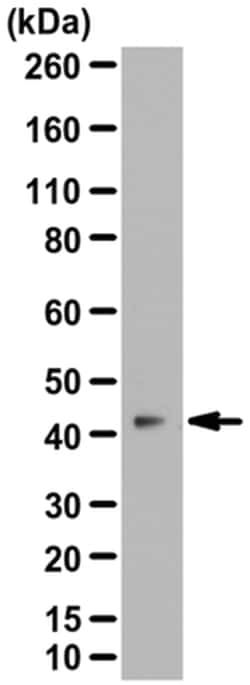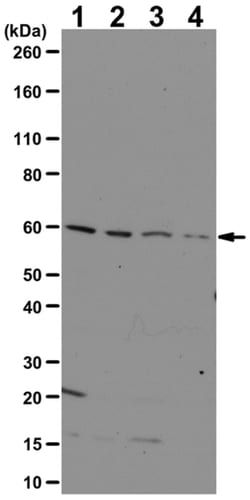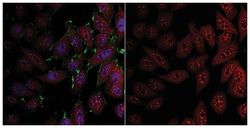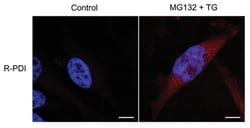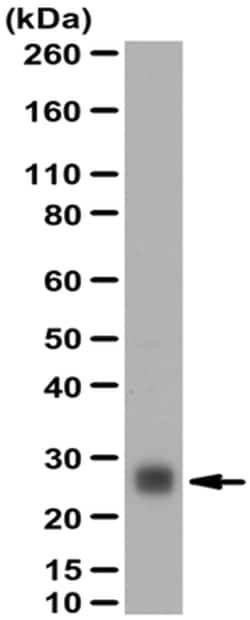MilliporeSigma™ anti-GSTT1, Polyclonal
Manufacturer: MilliporeSigma™
Select a Size
| Pack Size | SKU | Availability | Price |
|---|---|---|---|
| Each of 1 | ABS1653MI-Each-of-1 | In Stock | ₹ 40,292.08 |
ABS1653MI - Each of 1
In Stock
Quantity
1
Base Price: ₹ 40,292.08
GST (18%): ₹ 7,252.574
Total Price: ₹ 47,544.654
Antigen
GSTT1
Classification
Polyclonal
Formulation
Rabbit polyclonal antibody in serum with 0.05% sodium azide.
Gene Symbols
GSTT1
Immunogen
His-tagged recombinant full-length human GSTT1.
Quantity
100 μL
Research Discipline
Signaling
Gene ID (Entrez)
NP_000844
Target Species
Human, Mouse, Rat
Form
Serum
Applications
Immunohistochemistry (Paraffin), Western Blot
Conjugate
Unconjugated
Gene Accession No.
P30711
Host Species
Rabbit
Purification Method
Unpurified
Regulatory Status
RUO
Primary or Secondary
Primary
Test Specificity
Expected to react with both spliced isoforms reported by UniProt (P30711). Note that not all human samples are positive for GSTT1 expression. It has been estimated that approx. 18% of the Caucasian, and as much as 60% of the Chinese and Korean populations are GSTT1-null (Katoh, T., et al. (1996) Carcinogenesis. 17(9):1855-1859; Lear, J.T., et al. (1996) Carcinogenesis. 17(9):1891-1896;).
Content And Storage
−20°C for one year
Related Products
Description
- Specifically detects GSTT1 Clone: in Human, Mouse, Rat samples, and it is validated for Immunohistochemistry (Paraffin), Western Blotting Glutathione S-transferase theta-1 (EC 2.5.1.18; UniProt P30711; also known as Glutathione S-transferase T1-1, GST class-theta-1, GST T1-1) is encoded by the GSTT1 gene (Gene ID 2952) in human
- Glutathione S-transferases constitute a family of metabolic isozymes that are involved in detoxification by catalyzing the conjugation of the reduced form of glutathione (GSH) to xenobiotic substrates
- The GST family can be subdivided into the cytosolic, mitochondrial, and microsomal (a.k.a
- MAPEG) proteins
- Mammalian GSTs exist as either homodimers or heterodimers
- The individual monomers were historically characterized by their quaternary structure and size, Yf (24.5kDa), Yk (25kDa), Ya1 (25.5kDa), Ya2 (25.5kDa), Yn (26.5kDa), Yb1 (27kDa), Yb2 (27kDa) and Yc (28.5kDa)
- The Y designation refers to the Y fraction (as apposed to the X and Z fractions) they were found in during purification by Sephadex G75 chromatography
- Two GST superfamilies exist that comprise either cytosolic or membrane-bound proteins
- Evidence suggests that cytosolic GST increases bodily resistance to carcinogens, products of oxidative stress, environmental pollutants and certain anti-cancer drugs
- The cytosolic GSTs are further subdivided into eight classes
- namely alpha (GSTA), mu (GSTM), pi (GSTP), sigma, theta (GSTT), kappa (GSTK), zeta (GSTZ), and omega (GSTO)
- GSTT1 exists as a homodimer, the subunit is referred to as subunit 5 in rat species, and T1-1 theta subunit in human.
